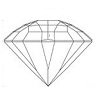16.03: Corundum
- Page ID
- 3272
| Corundum | |
|---|---|
| Chemical composition | Al2O3 |
| Crystal system | Trigonal |
| Habit | Prismatic, tabular |
| Cleavage | None; twinned stones may show parting |
| Fracture | Conchoidal |
| Hardness | 9 |
| Optic nature | Uniaxial - |
| Refractive index | 1.762-1.770 (+.009,-.005) |
| Birefringence | 0.008-0.010 |
| Dispersion | Low, 0.018 |
| Specific gravity | 4 |
| Lustre | Vitreous to Subadamantine |
| Pleochroism | Weak to moderate |
Corundum is an aluminum oxide that occurs in every color of the rainbow. It is allochromatic. When it is red, it is termed ruby. When it occurs in any other color, it is termed sapphire. There are two primary ways that corundum is formed. One is the metamorphosis of limestone and the other is an igneous occurrence in rocks lacking in silica. Since corundum is so hard, it is very resistant to weathering. Therefore, it accumulates in placer gravels. Placer deposits in Sri Lanka at Ratnapura have been mined since before the time of Buddha. The major sources for rubies today are Burma and Madagascar. The major source for sapphire is Madagascar. Other locations include Pakistan, Afghanistan, India, East Africa and Yogo Gulch in Montana.



